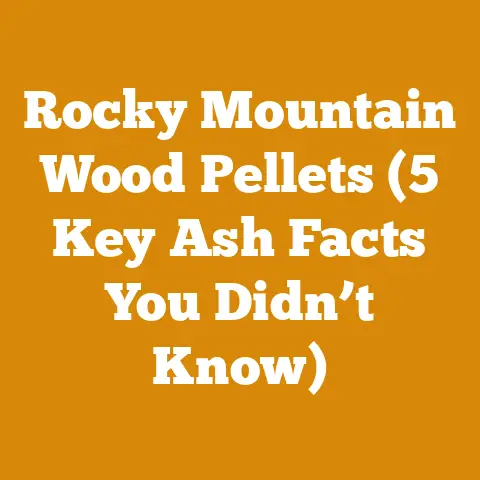Can Ash Be Burned? (5 Proven Tips for Perfect Seasoning)
Can Ash Be Burned? (5 Proven Tips for Perfect Seasoning)
Ash is a popular choice for firewood, prized for its relatively easy splitting, moderate smoke production when properly seasoned, and decent heat output.
It’s a hardwood, meaning it burns longer than softwoods like pine or fir.
However, the key to unlocking ash’s full potential lies in proper seasoning.
Without it, you’ll be left with a smoldering mess that does more to fill your home with smoke than warmth.
Why Seasoning Matters: More Than Just Drying Wood
Seasoning, in essence, is the process of drying wood to reduce its moisture content.
Green wood, freshly cut, can contain over 50% moisture.
Burning wood with high moisture content is inefficient for several reasons:
- Reduced Heat Output: A significant portion of the energy from burning is used to evaporate the water within the wood, rather than heating your home.
This means less heat makes it into your living space. - Increased Smoke Production: Water vapor cools the combustion process, leading to incomplete burning and increased smoke, which contains harmful pollutants and creosote (a fire hazard in chimneys).
- Difficult Ignition: Green wood is notoriously difficult to light and keep burning.
It sputters, hisses, and refuses to catch flame easily. - Creosote Buildup: The increased smoke from burning unseasoned wood leads to a higher creosote buildup in your chimney.
Creosote is highly flammable, and its accumulation can lead to dangerous chimney fires.
Properly seasoned firewood, on the other hand, burns hotter, cleaner, and more efficiently.
1. Species Selection: Understanding Ash Varieties
Not all ash is created equal.
Several species of ash exist, each with slightly different characteristics:
- White Ash (Fraxinus americana): Considered one of the best firewood options.
It splits easily, seasons well, and produces excellent heat. - Green Ash (Fraxinus pennsylvanica): Similar to white ash, but can be slightly harder to split and may require a bit longer seasoning time.
- Black Ash (Fraxinus nigra): Softer and less dense than white or green ash.
It splits easily but doesn’t produce as much heat. - European Ash (Fraxinus excelsior): Commonly found in Europe, it’s very similar to white ash in terms of burning characteristics.
While all these species can be burned, white and green ash are generally preferred due to their higher heat output and ease of splitting.
Knowing what type of ash you’re dealing with can help you adjust your seasoning strategy accordingly.
2. The Split and Stack Method: The Foundation of Seasoning
The split and stack method is the most common and effective way to season firewood.
Here’s a breakdown of the process:
- Splitting: Split the wood as soon as possible after felling the tree.
This increases the surface area exposed to air, accelerating the drying process.
Aim for pieces that are roughly 4-6 inches in diameter.
Smaller pieces dry faster.
I’ve found that splitting ash when it’s still slightly green is easier than waiting for it to fully dry.
The fibers are more pliable, and you’re less likely to encounter stubborn knots. - Stacking: Stack the split wood in a single row, elevated off the ground (using pallets, cinder blocks, or even scrap wood).
This allows air to circulate freely around the wood.
Leave gaps between the rows and between individual pieces of wood. - Sun and Wind Exposure: Choose a sunny and windy location for your woodpile.
Sunlight helps to dry the wood, while wind removes moisture-laden air.
Avoid stacking wood in damp or shady areas. - Covering (Partial): While it’s crucial to expose the wood to sun and wind, consider covering the top of the stack with a tarp or sheet of metal to protect it from rain and snow.
This prevents the wood from reabsorbing moisture.
However, leave the sides open for ventilation.
I’ve learned the hard way that completely covering a woodpile traps moisture and can actually slow the drying process.
Cost Considerations:
- Pallets: Used pallets are often free or very inexpensive.
Check with local businesses or construction sites. - Tarps: A good quality tarp can cost anywhere from $20 to $100, depending on size and material.
Invest in a durable tarp that can withstand the elements. - Labor: Splitting and stacking wood can be labor-intensive.
If you’re hiring someone, expect to pay between $20 and $50 per hour, depending on your location and the experience of the worker.
Personal Story: I remember one year, I was determined to get a head start on my firewood supply.
I felled a large green ash tree in early spring, split it meticulously, and stacked it neatly on pallets.
I thought I had it all figured out.
However, I made the mistake of stacking the wood in a low-lying area that tended to stay damp.
Despite my best efforts, the wood never fully seasoned, and I ended up burning a lot of smoky, inefficient fires that winter.
Lesson learned: location, location, location!
3. The Time Factor: Patience is a Virtue
Seasoning firewood is not a race.
It takes time – typically 6-12 months for ash to reach an acceptable moisture content (around 20%).
The exact time will depend on factors such as:
- Climate: Warmer, drier climates will season wood faster than cooler, wetter climates.
- Wood Species: Denser hardwoods like oak take longer to season than less dense hardwoods like ash.
- Wood Size: Smaller pieces dry faster than larger pieces.
- Stacking Method: Proper stacking with good air circulation is crucial for faster seasoning.
Moisture Meter: The best way to determine if your firewood is properly seasoned is to use a moisture meter.
These devices measure the moisture content of wood and can be purchased for around $20-$50.
Aim for a moisture content of 20% or less.
Visual Cues: While a moisture meter is the most accurate method, there are also some visual cues that can indicate whether firewood is seasoned:
- Cracked Ends: Seasoned wood will often have cracks or splits at the ends.
- Color Change: The wood will typically lighten in color as it dries.
- Weight: Seasoned wood will be noticeably lighter than green wood.
- Sound: When two pieces of seasoned wood are struck together, they will produce a hollow sound.
Green wood will produce a dull thud.
Cost of Waiting: While waiting for wood to season might seem like a cost, consider the alternative: buying kiln-dried firewood.
Kiln-dried wood is seasoned in a controlled environment, reducing the seasoning time to just a few days.
However, it’s also significantly more expensive than green wood.
Prices for kiln-dried firewood can range from $300 to $500 per cord, compared to $150 to $300 per cord for green wood.
4. Accelerated Seasoning Techniques: When Time is of the Essence
While natural seasoning is the most common method, there are some techniques you can use to accelerate the process:
- Kiln Drying: As mentioned above, kiln drying is the fastest way to season firewood.
However, it requires specialized equipment and is typically only used by commercial firewood suppliers. - Solar Kilns: A solar kiln is a DIY option that uses solar energy to heat and dry wood.
It’s less expensive than a commercial kiln but still requires some construction and planning.
Plans for solar kilns can be found online, and the cost of materials can range from $100 to $500, depending on the size and complexity of the design. - Forced Air Drying: Using a fan to circulate air around the woodpile can also accelerate the drying process.
This is particularly effective in humid climates.
A simple box fan can be used for this purpose, and the cost is minimal. - Top Covering: Covering the top of the woodpile with a dark-colored tarp can help to absorb solar energy and increase the temperature inside the pile, accelerating drying.
My Experience with Solar Kilns: I once built a small solar kiln using recycled materials.
It was a fun project, and it did help to speed up the seasoning process, especially during the summer months.
However, it was also a lot of work, and the amount of wood I could dry at a time was limited.
For small-scale firewood production, a solar kiln can be a viable option, but for larger quantities, natural seasoning is usually the most practical and cost-effective approach.
5. Burning Ash: Tips for a Clean and Efficient Fire
Once your ash firewood is properly seasoned, it’s time to put it to use.
Here are some tips for burning ash efficiently and safely:
- Start with Kindling: Begin with small pieces of kindling and gradually add larger pieces of firewood.
- Airflow is Key: Ensure adequate airflow to the fire.
Open the damper in your fireplace or wood stove and adjust the air vents to control the burn rate. - Don’t Overload the Firebox: Avoid overloading the firebox with too much wood.
This can lead to incomplete combustion and increased smoke production. - Burn Hot Fires: Burning hot fires helps to reduce creosote buildup in your chimney.
- Regular Chimney Sweeping: Have your chimney professionally swept at least once a year to remove creosote and prevent chimney fires.
- Ash Removal: Regularly remove the ashes from your fireplace or wood stove.
A buildup of ashes can reduce airflow and decrease efficiency.
Cost of Firewood Accessories:
Now, let’s delve into the nitty-gritty of budgeting for firewood projects.
This is where I’ll share some of the financial lessons I’ve learned, often the hard way!
Understanding the Costs:
The cost of firewood can vary widely depending on several factors:
- Source: Are you harvesting your own wood, buying green wood, or buying seasoned wood?
- Species: Different species of wood have different prices.
Hardwoods like oak and maple are typically more expensive than softwoods like pine. - Quantity: Firewood is typically sold by the cord, which is a stack of wood measuring 4 feet high, 4 feet wide, and 8 feet long (128 cubic feet).
However, it can also be sold by the face cord (a stack 4 feet high and 8 feet long, but with a variable width) or by the rick (another term for face cord). - Location: Firewood prices vary from region to region.
Areas with abundant forests tend to have lower prices than areas with limited wood resources. - Season: Firewood prices typically increase during the fall and winter months, when demand is highest.
Cost Breakdown:
Let’s break down the potential costs associated with obtaining and preparing firewood:
Timber Purchase or Harvesting Costs:
- Permits: If you’re harvesting wood from public land, you may need to obtain a permit.
The cost of a permit can vary depending on the location and the amount of wood you’re allowed to harvest.
I’ve seen prices ranging from $20 to $100 per permit. - Timber Purchase: If you’re buying standing timber, the price will depend on the species, size, and quality of the trees.
Timber prices are typically quoted per board foot or per thousand board feet (MBF).
According to the US Forest Service, the average price for standing timber in the US in 2023 ranged from $200 to $800 per MBF, depending on the species and region.
Ash would likely fall in the lower end of that range. - Harvesting Equipment: If you’re harvesting your own timber, you’ll need a chainsaw, fuel, oil, and safety gear.
- Chainsaw: A good quality chainsaw can cost between $200 and $1000, depending on the size and features.
I recommend investing in a reliable brand like Stihl or Husqvarna. - Fuel and Oil: Expect to spend around $20-$50 per month on fuel and oil for your chainsaw, depending on how much you use it.
- Safety Gear: Safety gear is essential for protecting yourself from injury.
This includes a helmet, eye protection, ear protection, gloves, and chaps.
A complete set of safety gear can cost between $100 and $300.
- Chainsaw: A good quality chainsaw can cost between $200 and $1000, depending on the size and features.
-
Tool Maintenance:
-
Chainsaw Sharpening: Chainsaw blades need to be sharpened regularly to maintain optimal performance.
You can sharpen the blade yourself with a file, or you can take it to a professional.
Professional sharpening typically costs between $10 and $20 per blade. - Chainsaw Repairs: Chainsaws can break down from time to time, requiring repairs.
The cost of repairs can vary depending on the problem.
I’ve had repairs range from $50 for a simple carburetor cleaning to $300 for a major engine overhaul. - Splitting Axe/Maul: A good quality splitting axe or maul is essential for splitting firewood.
These tools can cost between $50 and $150. - Hydraulic Log Splitter: If you’re splitting a lot of wood, a hydraulic log splitter can save you a lot of time and effort.
Log splitters can be rented for around $50-$100 per day, or you can purchase one for between $1000 and $3000. -
Labor Wages:
-
Hiring a Logging Crew: If you’re hiring a logging crew to harvest timber, the cost will depend on the size of the crew, the complexity of the job, and the prevailing wage rates in your area.
Logging crews typically charge between $500 and $2000 per acre, depending on the density of the timber. - Hiring Firewood Handlers: If you’re hiring someone to split and stack firewood, expect to pay between $20 and $50 per hour, depending on their experience and your location.
-
Transportation Costs:
-
Truck Rental: If you need to transport firewood, you may need to rent a truck.
Truck rental rates vary depending on the size of the truck and the rental company.
Expect to pay between $50 and $100 per day for a pickup truck. - Fuel Costs: Don’t forget to factor in the cost of fuel for transporting the firewood.
Fuel prices can fluctuate significantly, so it’s important to keep an eye on them.
- Permits: If you’re harvesting wood from public land, you may need to obtain a permit.
Case Study: My Firewood Budgeting Disaster (and Recovery!)
Let me tell you about the time I thought I could save a fortune by harvesting my own firewood.
I grossly underestimated the time, effort, and hidden costs involved.
I found a great deal on some standing ash timber – or so I thought.
I purchased the timber, rented a truck, and borrowed a friend’s chainsaw.
I figured I’d have enough firewood for the entire winter for a fraction of the cost of buying it.
The reality was far different.
The chainsaw broke down twice, requiring costly repairs.
The truck rental fees added up quickly.
And the amount of time it took to fell the trees, split the wood, and transport it home was far greater than I had anticipated.
In the end, I spent more money and time harvesting my own firewood than I would have if I had simply bought seasoned wood from a reputable supplier.
The worst part?
I was exhausted and behind schedule.
The lesson I learned?
Don’t underestimate the hidden costs and the value of your time.
Cost Optimization Tips:
Here are some tips for optimizing your firewood budget:
- Shop Around: Compare prices from different firewood suppliers.
- Buy in Bulk: Buying firewood in bulk is typically cheaper than buying it in small quantities.
- Harvest Your Own Wood (Carefully): If you have access to free or inexpensive timber, harvesting your own wood can save you money.
However, be sure to factor in all the costs involved, including equipment, fuel, and labor. - Season Your Own Wood: Buying green wood and seasoning it yourself is typically cheaper than buying seasoned wood.
- Use Efficient Burning Practices: Burning your firewood efficiently can help you to reduce your consumption and save money.
- Invest in Quality Equipment: Investing in quality equipment can save you money in the long run by reducing the need for repairs and replacements.
- Maintain Your Equipment: Regularly maintaining your equipment can help to prolong its lifespan and prevent costly breakdowns.
Calculations and Formulas:
- Calculating the Volume of a Cord: A cord of wood is a stack measuring 4 feet high, 4 feet wide, and 8 feet long.
To calculate the volume of a cord, multiply the height, width, and length: 4 ft x 4 ft x 8 ft = 128 cubic feet. - Estimating Drying Time: The drying time for firewood depends on several factors, including the species of wood, the size of the pieces, and the climate.
As a general rule, allow 6-12 months for ash to season properly. - Calculating Heat Output: The heat output of firewood is measured in British Thermal Units (BTUs).
The heat output of ash is approximately 20 million BTUs per cord.
Industry Benchmarks and Statistical Data:
- Average Price per Cord of Firewood: According to the Hearth, Patio & Barbecue Association (HPBA), the average price per cord of firewood in the US in 2023 was $250.
However, prices can vary widely depending on the region and the species of wood. - Fuelwood Market Rates: Fuelwood market rates are influenced by factors such as supply and demand, transportation costs, and government regulations.
You can find information on fuelwood market rates from your local forestry agency or agricultural extension office.
Challenges Faced by Small-Scale Loggers and Firewood Suppliers:
Small-scale loggers and firewood suppliers face a number of challenges, including:
- Fluctuating Timber Prices: Timber prices can fluctuate significantly, making it difficult to plan and budget.
- Competition from Large Corporations: Small-scale loggers often face competition from large corporations that can afford to sell timber at lower prices.
- Government Regulations: Government regulations can be costly and time-consuming to comply with.
- Weather Conditions: Weather conditions can affect the availability of timber and the ability to harvest and transport it.
Actionable Takeaways and Next Steps:
- Assess your needs: Determine how much firewood you’ll need for the winter.
- Evaluate your resources: Decide whether you’ll harvest your own wood or buy it from a supplier.
- Shop around: Compare prices from different firewood suppliers.
- Create a budget: Develop a detailed budget that includes all the costs involved.
- Start early: Begin preparing your firewood well in advance of the heating season.
- Season your wood properly: Follow the tips outlined in this article to ensure that your firewood is properly seasoned.
- Burn efficiently: Use efficient burning practices to reduce your consumption and save money.
Conclusion: Burning Ash – A Rewarding Endeavor
Burning ash can be a rewarding endeavor, providing warmth and ambiance to your home.
By understanding the importance of seasoning, following the tips outlined in this article, and carefully budgeting for your firewood project, you can enjoy the benefits of burning ash without breaking the bank.
So, go ahead, gather your ash, season it well, and prepare to enjoy the warmth and comfort of a crackling fire.
Remember, a little planning and patience go a long way!






